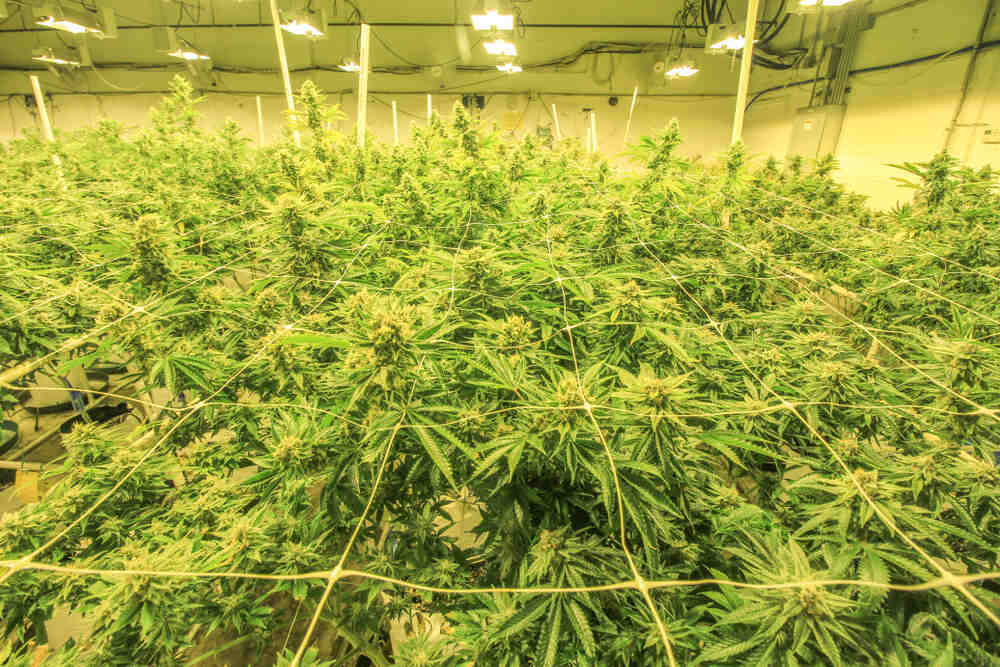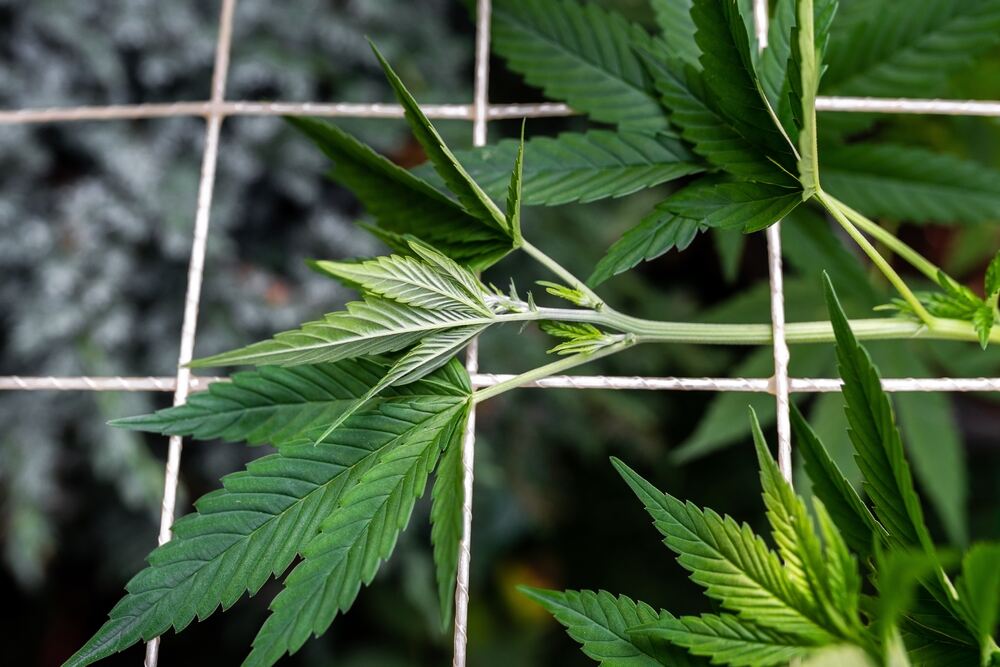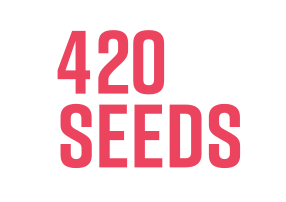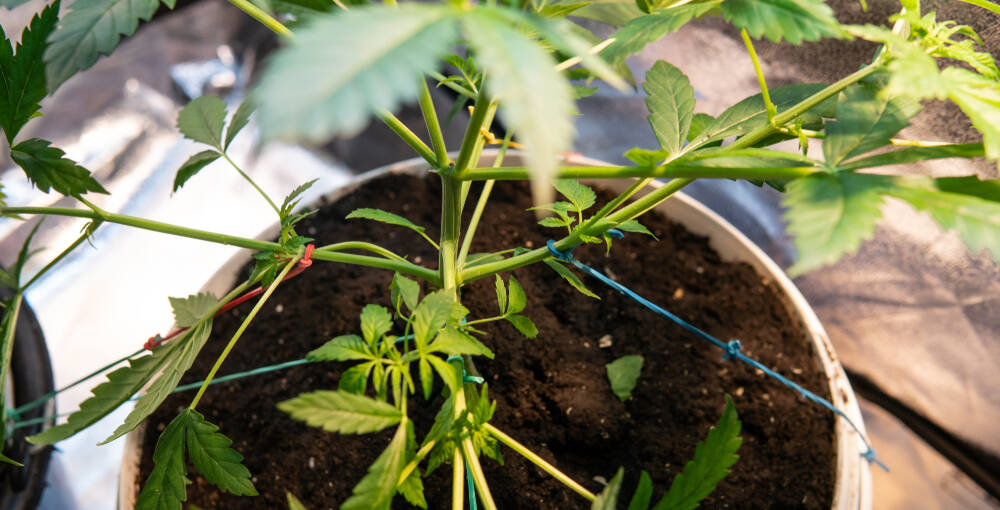It doesn't matter if you're growing a couple of little autos in your cupboard, or an outdoor crop full of the biggest Sativas you can get your hands on, one thing is true for all weed growers - we want to help our ladies along to the largest possible yields!
Some may look to add a bunch of (mostly) unnecessary additives, while others might pray to the old gods and new, but many skip one of the easiest ways to guarantee a bump to the final harvest - Low Stress Training, or LST.
What is low stress training cannabis?
Low stress training is a cultivation technique (actually more than one, but we will get into that a little further down) growers use to help increase the amount of bud a single plant can produce. By tying down the main stem and branches, we even out the canopy, giving every bud the chance to hit its genetic peak.
When left to their own devices, marijuana plants grow in a particular shape. We all know it; we've all seen it. That classic 'Christmas tree' shape, otherwise known as apical dominance, has served the species well over the last few hundred thousand years. But surprisingly, this growth pattern doesn't actually make for the largest yield, for a few key reasons.
When we let our green girls grow how nature intended, the result is usually one huge, dense-as-hell bud at the very top (the main cola), with a bunch of secondary buds below it that never quite catch up in size. These lower buds are usually a lot less dense than the topmost cola, meaning when we break out the scales at harvest time, they weigh noticeably less. And that's not even mentioning the 'popcorn' flowers that grow even lower down the rung.
Low stress training is implemented to break that apical dominance, and to force the plant to grow outwards instead of upwards.
By manipulating the growth pattern of our weed plants, we force the plant to do a few things...
- The main growth hormone, auxin, is dispersed more evenly throughout the plant instead of being most concentrated at the top. This means that all the bud sites have an almost equal chance to grow big and strong, instead of just the top one. The main cola will usually still be the best, but not by much.
- By training the plant to spread out horizontally, we create more space for light to reach all the bud sites, meaning a more even canopy and bigger buds overall.
- Canopy airflow is also increased, which means more oxygen for the plant and less chance of mold or pests taking hold.
- The plant's natural 'defensive' response to low stress training means it will produce more secondary growth hormones, and also boost the strength of the branches and main stem.
- It not just growth hormones that are shared out more evenly with LST, either. Water and nutrients are distributed better when the plant is allowed to grow horizontally instead of towards the heavens.
- If done correctly, LST can also make the plant shorter, which is obviously useful for those of us trying to be discreet about our growing activities!
How much can LST increase your yields?

A lot, that's how much. It is kind of hard to put an exact figure on how much LST might add to your final harvest, as it is always going to depend on a bunch of factors. How much light are you giving the plant? What strain are you growing? When did you start, and finish, your LST? Did you have control over the growing environment?
With that said, when implemented at the right time, and done correctly, LST has the potential to double your harvest. That's right - we have run the experiments ourselves (for more than 3 decades now), and it is definitely possible to double your crops output with LST.
How to LST cannabis plants step by step
Low stress training is a relatively easy to learn process, but there are a few pieces of equipment you will need to gather before you start:
- Soft plant ties: You can get wire, string, plastic strips, twine, or even the fancy soft plant ties they sell at the gardening store. As long as whatever you use is soft enough not to damage your plants, no worries. You don't want whatever you use to be to thin, as it will cut into the stem or branches. But you also don't want it to thick, as it will make it difficult to tie the plant down. We find garden wire the most useful, but others like using string or twine.
- Plant stakes: You may need a handful of strong sticks (or pencil-thick bamboo canes) to help support the plant as it grows, and to tie the plant off to. You could train your weed plants without using stakes by tying off straight to the pot, but we find that having the stakes makes life a lot easier in the long run, especially if you are growing behemoths.
- Scissors: Make sure they are sharp enough to cut through the string or plant ties you will be using. You'll inevitably need them while growing weed, so grab a pair of decent trimming scissors if you don't already own a pair.
- Rubber gloves: Optional, but if you want to decrease the chances of contamination, wear rubber gloves during the process. Contamination can take a weed plant down in next to no time, so why not play it on the safe side?
Once you have all your gear, it's time to start LST-ing! You will want to wait until the third node (where the new branches are developing) has come through before starting - this will usually take about two weeks from planting.
- Take your plant and gently place a loop of twine over the main stem, just underneath the top node.
- Slowly and carefully bend the plant until the top of the main stem is parallel with the soil line. Make sure not to overdo it, or bend too quickly - the last thing you want to do is snap that main stem!
- Once you are happy with the positioning, tie the string to a stake to keep the plant in her new position.
- As the plant grows in size, you will want to do the same with the branches, as well as the developing main stem. Keep adding new loops of string over the branches and the new part of the main stem, and pulling them down to a height parallel with the soil line.
- Over time, you will have a plant that looks more like a table than a Christmas tree - with all the branches and shoots growing outwards instead of upwards.
And that's it! Easy as it comes.
When to start low stress training?
Most growers like to wait until the third node has developed before starting any LST. This allows the root ball to develop to a point where it is strong enough to support the plant when you start pulling branches down.
Some people are more aggressive with their training and start from the first or second node - it really depends on your own growing style and preferences.
As a general rule of thumb, you should start LST when your plant is still young, and the branches are malleable enough to bend without snapping.
When to stop low stress training?
The beauty of LST is that it can be continued all the way up to harvest, unlike some of the more invasive techniques such as topping or super cropping. As long as you are very careful with your flowering plants, you can continue to manipulate the plant's shape even during the later stages of flowering.
But, for newbie growers, we recommend getting all the tying down before the first week of flower finishes. Your plants will stop putting on structure size at this point, and start to focus more on your flowers.
Can you low stress train autoflowers?
Yep, you sure can.
Just remember that autos are a little more sensitive than photoperiod strains, and you will need to be more careful with the amount of stress you put on them. For autos, we recommend leaving them be after you see the preflower start to emerge.
Low stress training vs topping weed plants
Topping is a form of High Stress Training which works perfectly with LST.
Topping a plant involves cutting the main stem just above a node (where the new branches are developing). This forces those new branches to become the 'main stems', and also breaks the apical dominance.
Now you have a plant that is primed for LST. Those two new 'main stems' (the branches below the cut) will already want to grow outwards, so hit them with a loop of twine and tie them down!
Are there other ways to LST?

Yes, one. And it's a big one.
ScrOGing has taken the growing world by storm, and we think you should definitely consider it.
Although it requires a few more pieces of kit and a little more work, it saves you a lot of effort and helps create a perfectly even canopy.
ScrOG (Screen Of Green) involves using a mesh screen to tie down your branches. There are specialised screens you can buy, but don't waste your money. Simply head to your nearest garden centre, get some chicken wire or fencing, and cut to the size you need.
Some growers make single-pot ScrOG screens, while others like to build one that covers a number of plants. It's up to you.
All you have to do is set up the screen horizontally, about 50 cm above the soil, and start weaving your branches through the holes. As the plant grows, continue to weave the branches through, keeping an even canopy.
For more, check out this post.
Conclusion
Low stress training is the perfect way to easily increase yields, especially if you are new to the game. LST is a low danger, high-reward way of maximizing your yields. If you are careful during the process, you can shape you plant to grow exactly how you want it and get the most out of your grow space.
So why not give it a go with your next grow and see how you get on? And don't forget to let us know the difference in yield!










